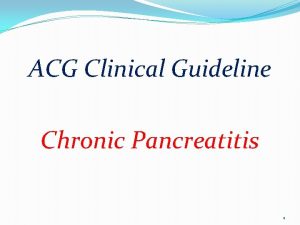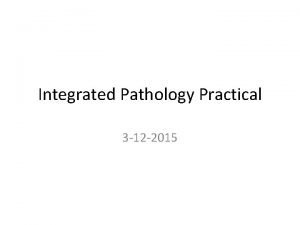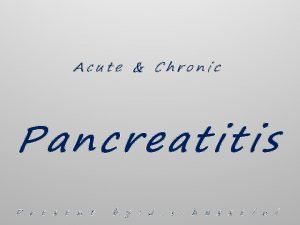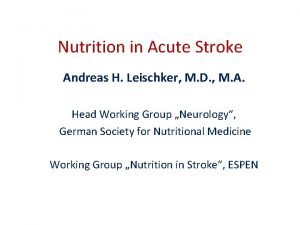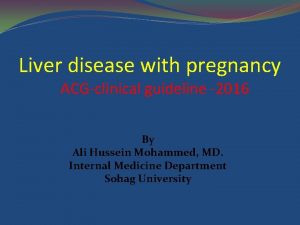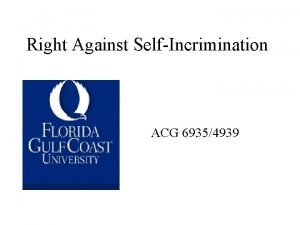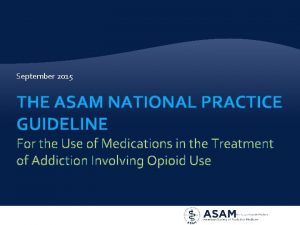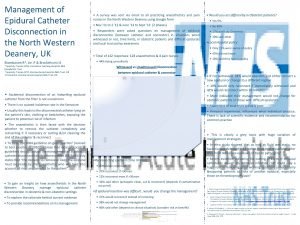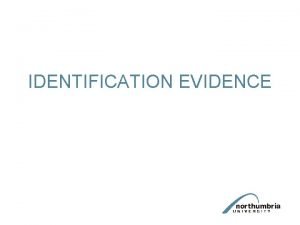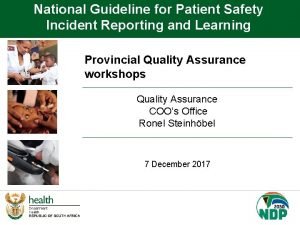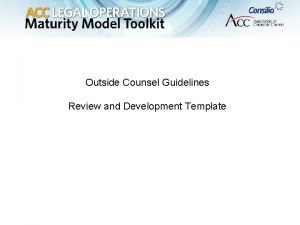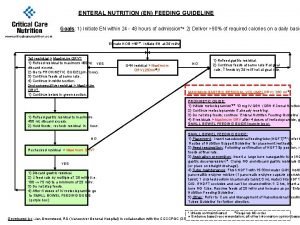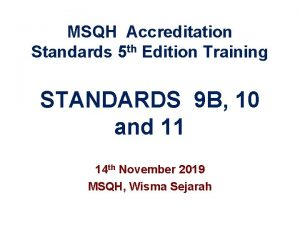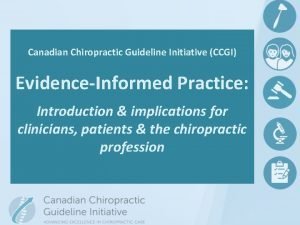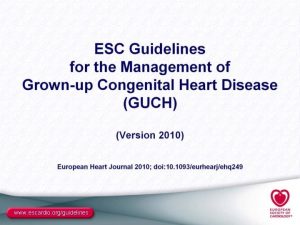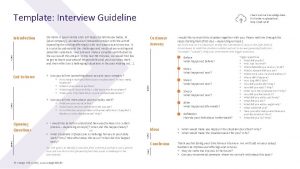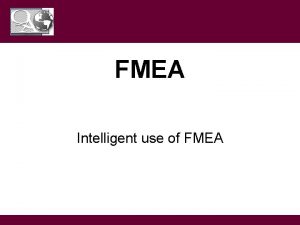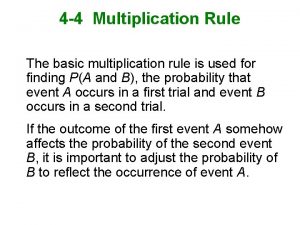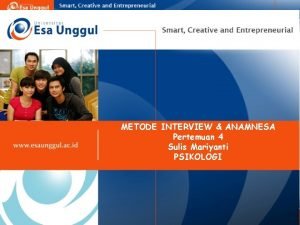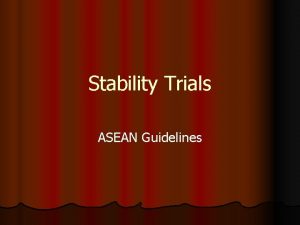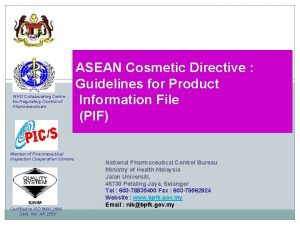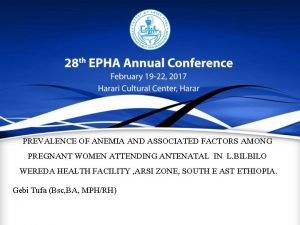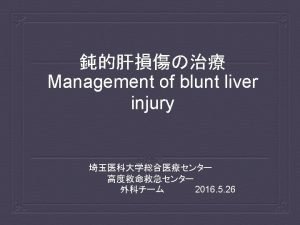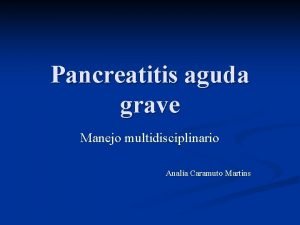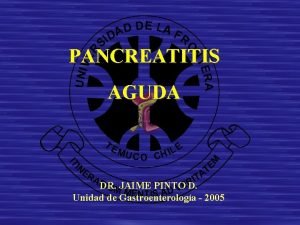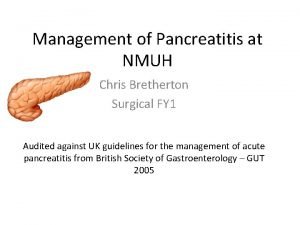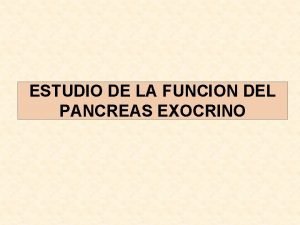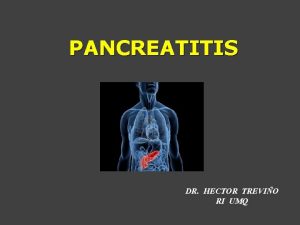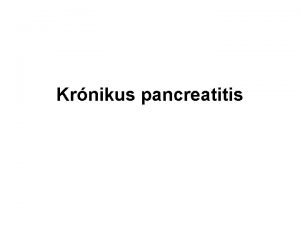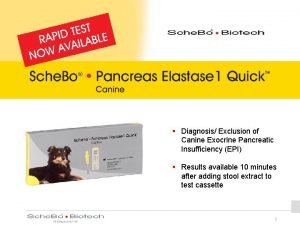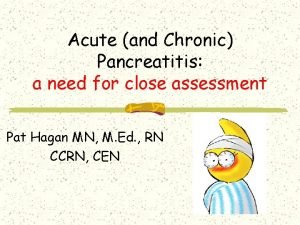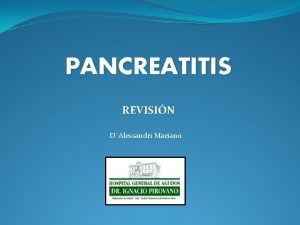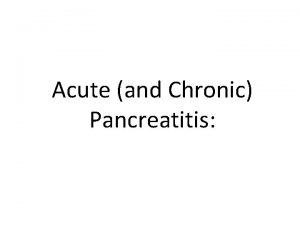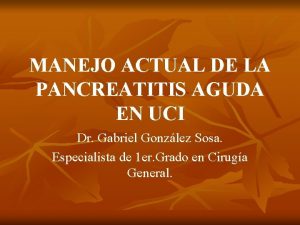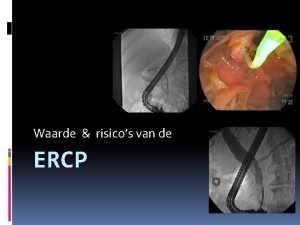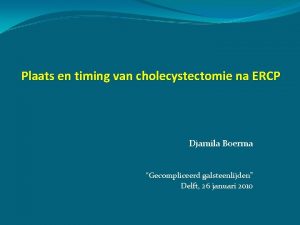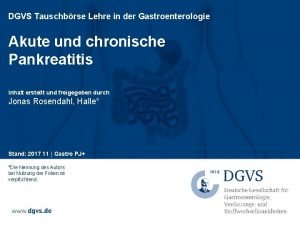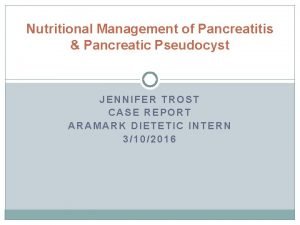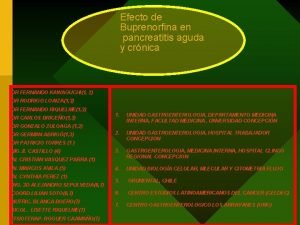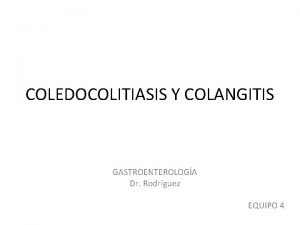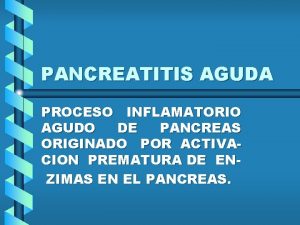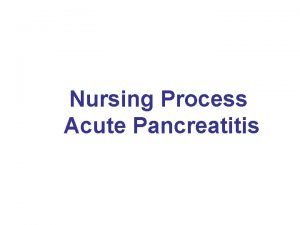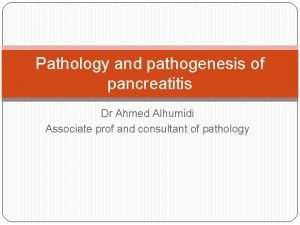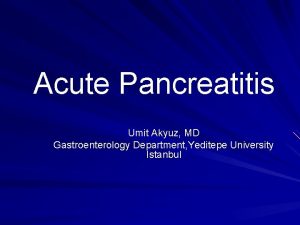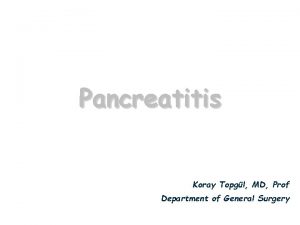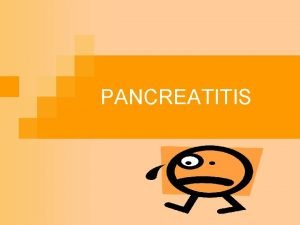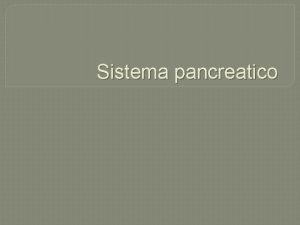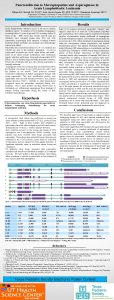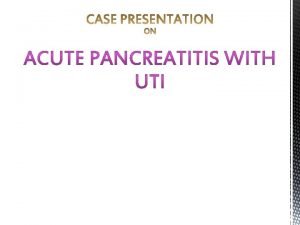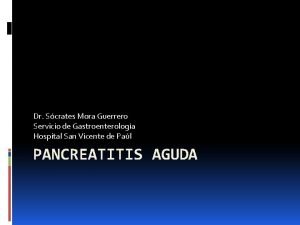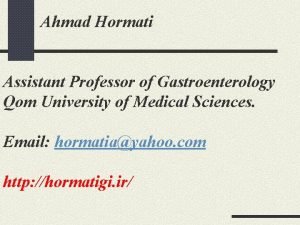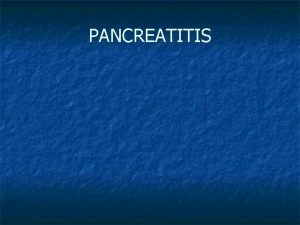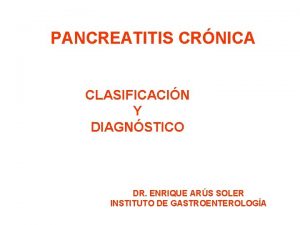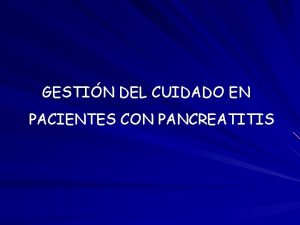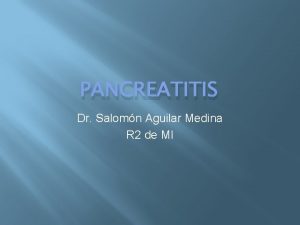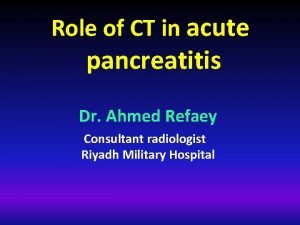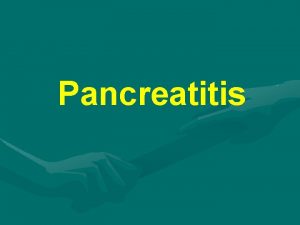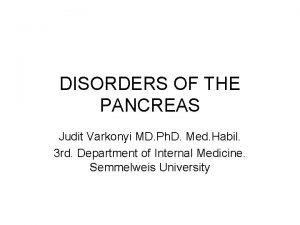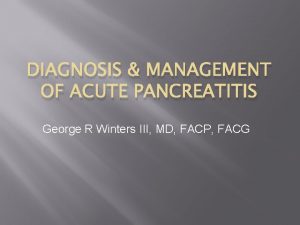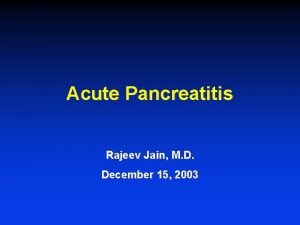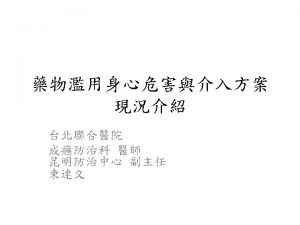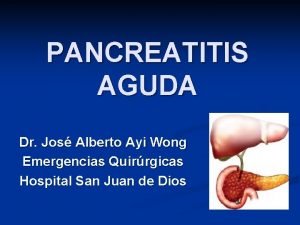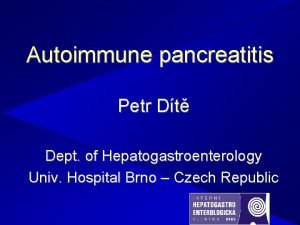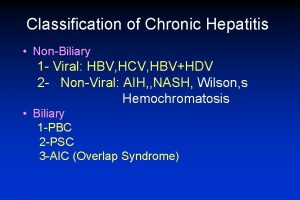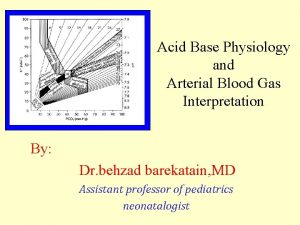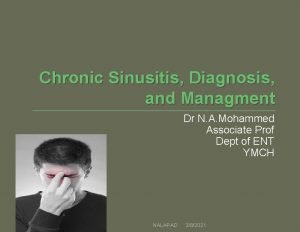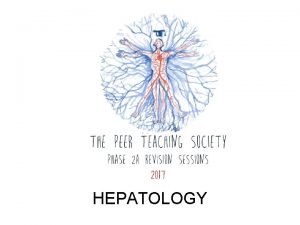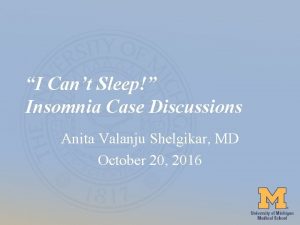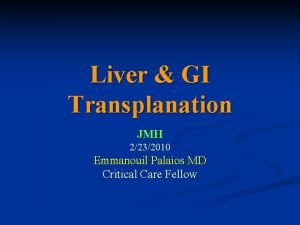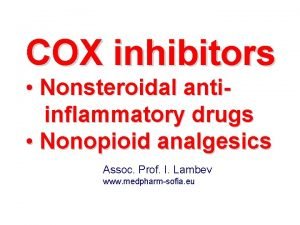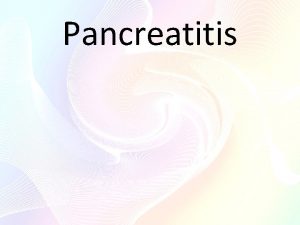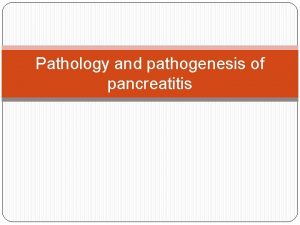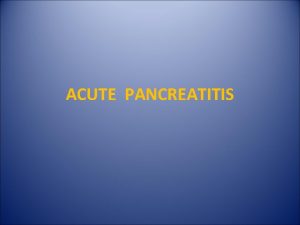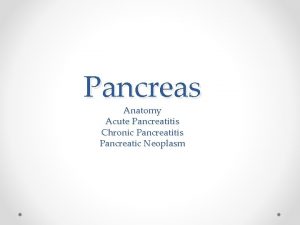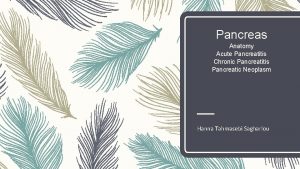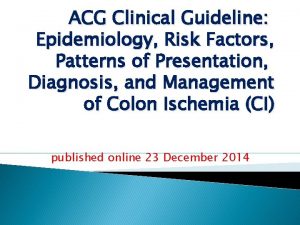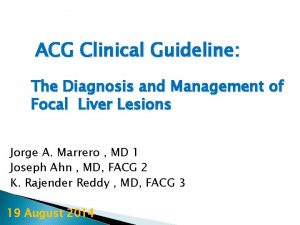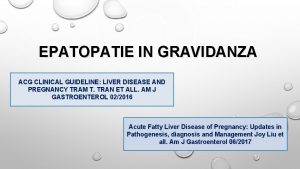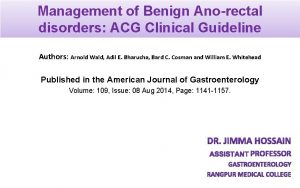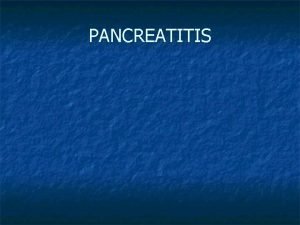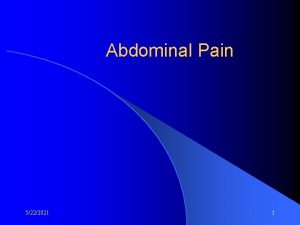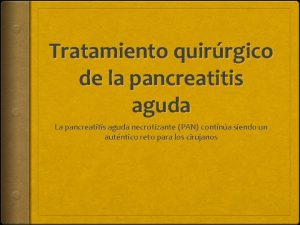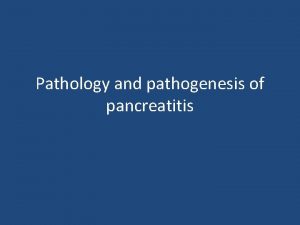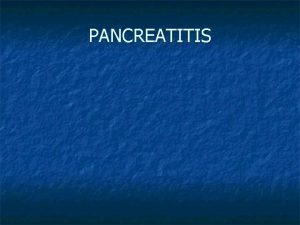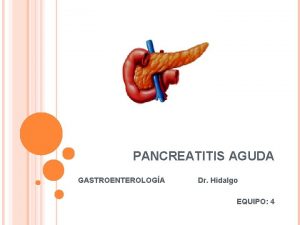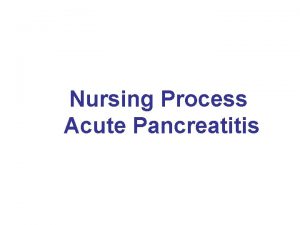ACG Clinical Guideline Chronic Pancreatitis 1 2 3

































































































- Slides: 97

ACG Clinical Guideline Chronic Pancreatitis 1

2

3

DIAGNOSIS OF CP: Recommendation 1: We recommend computed tomography (CT) or MRI for the first-line diagnosis of CP. Either test should be the first choice for the diagnosis of CP. Endoscopic ultrasonography (EUS), because of its invasiveness and lack of specificity, should be used only if the diagnosis is in question after cross-sectional imaging is performed (strong recommendation, low quality of evidence). 4

However, in patients with : clinical symptoms of an Inflammatory disorder of the pancreas (e. g. , previous Episode of acute pancreatitis, characteristic pain, and/or maldigestion) and/or a suggestive gene–environment risk assessment then crosssectional imaging should be the first test used to establish the diagnosis of CP because it is universally available, reproducible and valid when compared with other modalities. 5

The best evidence comparing modalities is from a systematic review and meta-analysis of 43 studies and 3460 patients with suspected CP in which the sensitivity estimates of EUS, MRI, and CT were 81% (95% confidence interval [CI]: 70%– 89%), 78% (95% CI: 69%– 85%), and 75% (95% CI: 66%– 83%), respectively, and did not differ significantly from each other. Estimates of specificity were comparable for EUS (90%; 95% CI: 82%– 95%), ERCP(94%; 95% CI: 87%– 98%), CT (91%; 95% CI: 81%– 96%), MRI(96%; 95% CI: 90%– 98%), and ultrasound (US) (98%; 95% CI: 89%– 100%). A limitation of this meta-analysis, however, was that not all the studies included a histologic gold standard to establish the type of inflammation for comparison. 6

Given the vast discrepancy in cost, availability, invasiveness, and objectivity, we believe that cross-sectional imaging should be the first-line test for the diagnosis of CP. 7

Multiple other imaging modalities and scoring systems Have been used to establish the diagnosis of CP, including : ü Contrast enhanced EUS ü ERCP ü transcutaneous ultrasonography ü pancreatic elastography. 8

Recommendation 2 We suggest performing secretin-enhanced magnetic Resonance cholangiopancreatography (s-MRCP) when the diagnosis of CP following cross-sectional imaging or EUS is not confirmed and the clinical suspicion remains high (conditional recommendation, low quality of evidence). 9

s-MRCP allows for better visualization of the main- and side-branch ducts by stimulating the release of bicarbonate from the pancreatic duct cells. It also allows for quantification of the degree of filling into the duodenum, which may correlate with the severity of CP and help quantify the degree of pancreatic exocrine function. 10

s-MRCP can be used to identify subtle ductal abnormalities such as dilated branches or an ectatic duct, which may indicate morphologic changes consistent with imaging criteria for CP. Given its expense, s-MRCP should be used only when the diagnosis is not confirmed with first-line testing. 11

Key concept 1 Pancreatic function testing is an important means of Diagnosing EPI; however, its role in establishing the diagnosis of CP is complementary. 12

the sensitivity of pancreatic function testing to make the diagnosis of CP is low. This is due in part to the large reserve within the Pancreas in which only significant loss of function (usually. 90%) results in the clinically apparent symptoms of steatorrhea, azotorrhea, and resultant vitamin. 13

There are multiple types of pancreatic function tests available and have historically been divided into direct and indirect types. The type of test used depends on clinical availability, provider expertise, patient tolerance, and expense. Table 4 details the type of pancreatic function testing available and the test characteristics of each. 14

15

Although a 72 -hour fecal fat measurement might be considered the gold standard for complete failure, most studies use either clinical steatorrhea or reduced levels of fecal elastase as the Primary diagnostic test. 16

Fecal elastase is most commonly used, but a number of caveats apply to the use of this test. The accuracy of fecal elastase to detect EPI depends on the cutoff chosen. Some studies have used levels of , 200 mg/g stool, but this level has a high false-positive rate. Lowering the cutoff to , 100 mg/g stool improves specificity but lowers sensitivity 17

Although used historically, serum trypsin and/or trypsinogen tests are typically not currently performed because of reports of ü Elevation in nonpancreatic pain syndromes ü Poor Correlation with imaging findings. 18

Recommendation 3 We suggest histological examination as the gold standard to diagnose CP in high-risk patients when the clinical and Functional evidence of CP is strong, but imaging modalities are inconclusive (conditional recommendation, very low quality of evidence). 19

With the recent widespread use of EUS-guided fine-needle biopsy techniques, the ability to acquire pancreatic tissue for histologic analysis is safer and technically easier 20

Histologic evaluation can be limited because of sampling error, complications inherent in obtaining the biopsy sample, the patchy nature of pancreatic inflammatory changes 21

Nonetheless, histologic confirmation can serve as the diagnostic gold standard, its value most important for ruling out CP when the diagnosis is under consideration. 22

ETIOLOGY OF CP Key concept 2 In patients with clinical features of CP, a comprehensive review of all risk factors should be performed. This provides information on the underlying mechanisms, identifies both fixed and modifiable risk factors, identifies potential targets for therapies, and Provides clinically relevant prognostic information. 23

The TIGAR-O system has been used to help categorize an etiology to explain CP, has proven useful in multiple international studies, and was recently revised to include new insights from the past 20 years. The acronym stands for T (Toxic-Metabolic), I (Idiopathic), G (Genetic), A(Autoimmune), R (Recurrent acute or severe pancreatitis), and O (Obstructive) (Table 5). 24

25

26

27

The pancreatitis with Multiple risk factors-Alcohol consumption, Nicotine consumption, Nutritional factors, Hereditary factors, Efferent duct factors, Immunological factors, Miscellaneous and rare metabolic factors (M-ANNHEIM) system is a similar multirisk factor classification system that attempts to add information on disease activity and stage and has been used to evaluate the impact and interaction of various risk factors on the course of CP 28

29

30

31

The initial approach to evaluation of patients with suspected pancreatitis-related disorders and CP is to complete a thorough history and physical examination, Along with biomarker tests. 32

The history should include previous dates and number of episodes of acute pancreatitis (outlined in TIGARO or M-ANNHEIM), ü dates of onset of DM (if present) ü maldigestion/malnutrition, weight loss ü bone health (e. g. , fractures) ü renal disease ü and diseases in organs associated with cystic fibrosis (e. g. , 33

Imaging is also useful in identifying potential obstructive etiologies of pancreatic disease, including anatomical malformations, pancreatic stones, tumors, and other features. 34

If the etiology is unclear if the patient has a family history of pancreatic diseases, if the disease persists after therapeutic intervention (e. g. , RAP after clearing the biliary system), or if the patient is young (e. g. , less than 35 years of age), then genetic testing is indicated. 35

It is also imperative to consider the differential diagnosis for CP, including ü autoimmune inflammation, inflammation and fibrosis arising from the pancreatic islet cells related to ü long-standing DM ü renal disease causing secondary effects on the pancreas ü medications that alter the immune system (e. g. , cyclosporine) ü age-related atrophy or fibrosis ü Intraductal papillary mucinous neoplasms ü acinar cell cystadenoma ü the desmoplastic response to pancreatic neoplasm, ü Inflammation upstream of a duct-obstructing mass, and other disorders 36

Recommendation 4 We recommend genetic testing in patients with clinical evidence of a pancreatitis-associated disorder or possible CP in which the etiology is unclear, especially in younger patients (strong recommendation, low quality of evidence). 37

38

39

40

At minimum, patients with idiopathic CP should be evaluated for : PRSS 1, SPINK 1, CFTR, CTRC gene mutation analysis, 41

Key concept 3 Identification of the disorders(s) underlying pancreatic inflammation is important in predicting progression to CP. 42

In general, a particular etiology of CP has not been proven to determine important clinical outcomes, such as rapid progression, EPI, chronic severe pain, or risk of malignancy. However, in certain well-characterized disease states such as autoimmune pancreatitis in which pain is not a frequent complication, etiology may determine outcomes and symptoms, and thus, identification of the disorder causing pancreatic inflammation can be important in predicting progression of CP. 43

Key concept 4 The development of DM in CP is most likely related to duration of disease, although other etiologic factors such as body mass index and smoking status may incur an increased risk. 44

Although patients who are obese are more likely to have type 2 DM, patients with advanced CP are more likely to have low body mass index and T 3 c. DM from islet cell loss. New-onset DM with weight loss is potentially also an indicator of pancreatic ductal adenocarcinoma 45

Recommendation 5 We recommend alcohol cessation in patients with CP (strong recommendation, very low quality of evidence). 46

Although the evidence is low quality, strict alcohol avoidance should be a cornerstone of any treatment program for patients with CP. 47

Recommendation 6 We recommend smoking cessation in patients with CP (strong recommendation, very low quality of evidence). 48

Although the evidence is low quality, strict smoking avoidance should be a cornerstone of any treatment program for patients with CP, recognizing however that the long-term success rate of smoking cessation is low. 49

Key concept 5 There is a lack of evidence to suggest that performing Screening examinations on patients with CP to detect pancreatic malignancy is beneficial. 50

This is based on the invasive and costly nature of testing, the inherent difficulty in screening given the structural changes of CP, and the inability to alter in many cases the natural history of the disease even if malignancy is detected at an early stage. 51

MANAGEMENT OF PAIN IN CP Key concept 6 Performing elective interventional procedures (such as celiac plexus interventions for pain palliation) on patients who are actively using alcohol should be considered cautiously. Patients requiring urgent or emergent procedures for complications of CP should be considered separately. 52

Alcohol abuse may be causing or worsening the very pain that these endoscopic and surgical procedures are meant to treat, and if alcohol cessation could be obtained, some (or all) of these interventions may not even be warranted. 53

Urgent interventions should be performed in patients who continue to consume alcohol given their medical necessity. Patients making good faith efforts to stop or reduce alcohol consumption but who still occasionally consume alcohol can be evaluated for interventional procedures on a case-by-case basis, recognizing the difficulties involved in alcohol cessation and the need to treat clinical symptoms of CP. 54

Recommendation 7 We recommend surgical intervention over endoscopic therapy in patients with obstructive CP for the long-term relief of pain if firstline endoscopic approaches to pancreatic drainage have been exhausted or unsuccessful (strong recommendation, moderate quality of evidence). 55

Patients with CP often experience pain in the setting of pancreatic duct obstruction. Duct obstruction can occur because of : ü pancreatic duct stones ü pancreatic duct strictures ü combination thereof 56

Endoscopic decompressive procedures include ERCP with ü pancreatic sphincterotomy, ü stone clearance ü stricture dilation ü pancreatic duct stenting Interventional EUS procedures that usually involve placement of a transluminal stent to allow for pancreatic duct decompression. 57

Several surgical decompressive procedures exist (Puestow, Frey, and Beger procedures) that may also include a component of partial pancreatectomy 58

59

Cahen et al randomized 39 patients with CP to undergo either endoscopic or surgical drainage of the pancreatic duct. In this study, patients who underwent surgery had lower pain scores (P , 0. 001) and better physical health summary scores (P 5 0. 003) when validated questionnaires were used. 60

At the end of 24 months of follow-up, complete or partial pain relief was achieved : in 32% of patients who underwent endoscopic drainage vs 75% of patients assigned to surgical drainage (P 5 0. 007). 61

ü Complication rates ü length of stay ü changes in pancreatic function were similar between the treatment groups. 62

As would be expected patients receiving endoscopic treatment required more interventions than patients who underwent surgery (a median of 8 vs 3, P , 0. 001). 63

This same group published a long-term follow-up study of these 39 patients lasting 79 months. Among patients in the original endoscopic group, 68% underwent additional drainage compared with 5%who underwent surgery (P 50. 001). Length of stay and costs were equivalent in the 2 groups. 64

Forty-seven percent of patients treated through endoscopy ultimately underwent surgery. Mean difference in validated pain scores was no longer significant (39 vs 22; P 5 0. 12), although surgery was superior In terms of pain relief (80% vs 38%; P 5 0. 042). Overall, patients’quality of life and pancreatic function were not felt to be different. 65

Although surgical approaches to pancreatic duct decompression have been shown to provide better long-term pain relief than endoscopic approaches, they are rarely first- line therapies and many surgeons only operate once endoscopic approaches to pancreatic drainage have been exhausted or unsuccessful. 66

Recommendation 8 We suggest considering the use of antioxidant therapy for CP With pain, although the benefit of pain reduction is likely limited (conditional recommendation, moderate quality of evidence). 67

The exact mechanism by which these agents could reduce pain is not fully clear. most theories propose that these agents : ü reduce oxidative stress ü and provide an anti inflammatory effect. If these agents were helpful, they could potentially be used as an alternative to other medications including narcotics. 68

The type of antioxidants used has widely varied in clinical practice, but clinical trials generally include at least selenium, ascorbic acid, b-carotene, and methionine. Unfortunately, the optimal type of antioxidants and dosage is not clear from previous studies. 69

Key concept 7 Opiates may be considered to treat painful CP only in patients in whom all other reasonable therapeutic options have been exhausted. 70

One trial evaluated the use of transdermal fentanyl vs sustained-release morphine tablets in 18 patients with CP. The study was a randomized cross-over trial. All patients were given immediate-release morphine tablets as a rescue medication. The authors concluded that transdermal fentanyl was not ideal for patients with CP because the dosage had to be increased 50% above the manufacturer’s recommendation, and patients on transdermal fentanyl required significantly more rescue morphine administration 71

Overall, if possible, opiates should be avoided to treat pain in patients with CP given the risks of addiction, abuse, and tolerance. Patients who have been previously prescribed opiates for CP should be encouraged to transition to other medications. 72

Recommendation 9 We do not suggest the use of pancreatic enzyme supplements To improve pain in CP (conditional recommendation, low quality of evidence). 73

Although it seems plausible that pain due to cramping, diarrhea, and other EPI symptoms could be treated by enzyme supplementation it is unclear whether these agents treat primary pancreatic pain due to inflammation, ductal stones, etc. 74

Nonetheless, if patients feel that their pain is improved on pancreatic enzyme therapy, especially non–enteric-coated formulations that have biologic plausibility, it is reasonable to continue these agents given their lowrisk of use and the lack of other low-risk analgesic alternatives. 75

Recommendation 10 We suggest considering celiac plexus block for treatment of pain in CP (conditional recommendation, very low quality of evidence). 76

Celiac plexus blockade refers to the injection of pharmaceuticals into and/or around the region of the celiac ganglia. The most common celiac plexus ingredients are combination of : ü local anesthetic bupivacaine ü steroid triamcinolone 77

Celiac plexus blockade can be performed through : ü endoscopy ü interventional radiology ü surgical approaches 78

Advantages of celiac plexus blockade include the fact that ü single treatment can potentially provide pain reduction ü or relief for 3– 6 months, may reduce or eliminate the need for Oral analgesia, and can be performed quickly and repeated as needed. 79

Disadvantages of celiac plexus blockade include the risks of the procedure itself (bleeding, allergic reaction, etc. ) and the risks of, and need for, sedation. 80

Although some studies have found that one approach is Superior to another with endoscopic approaches often being favored, in general celiac plexus blockade is felt to be similarly effective whether it is performed by an endoscopist, a radiologist, or a surgeon. The decision to choose one type of physician over another can be made based on experience and availability. 81

Key concept 8 TPIAT( total pancreatectomy with islet autotransplant) should be reserved for highly selected patients with Refractory chronic pain in which all other symptom control measures have failed. 82

Offered at only selected centers, TPIAT is a procedure whose outcomes or effectiveness have not been subjected to RCTs, Systematic reviews, or meta-analyses. Data consist exclusively of case series and cohort studies. As such, statements of its efficacy are limited, and it is critical that comparative effectiveness studies on important clinical outcomes be conducted in the future. 83

It is recommended that patients considering TPIAT be Evaluated at an expert center in which multidisciplinary evaluation is available. Patients undergoing TPIAT for treatment of painful CP need to be thoroughly vetted and appraised of the Subsequent risks of type 3 c DM and potential lifelong intestinal dysmotility disorders. 84

Key concept 9 Experimental treatment modalities should be limited to use in the context of a clinical research trial. 85

In hopes of treating refractory CP pain, various experimental treatment modalities such as : ü spinal cord nerve stimulation ü transmagnetic brain stimulation ü direct radiation therapy to the pancreatic bed Data on the efficacy of these modalities are limited to small Case series and retrospective cohort studies. Therefore, it is Recommended that use of these modalities be limited to a clinical Research trial. 86

MANAGEMENT OF EPI IN CP Recommendation 11 We suggest PERT in patients with CP and EPI to improve the complications of malnutrition (conditional recommendation, low level of evidence). 87

The benefits of using PERT could include : ü reduction in symptoms ü gain of weight ü improvement in fat absorption ü improvement in fat-soluble vitamin and trace element levels ü reduction in consequences of maldigestion (e. g. , risk of bone fracture due to osteoporosis) ü improvement in quality of life, or reduction in mortality. 88

EPI should be suspected in those with long-standing CP or in those with CP and ü weight loss, ü malnutrition, ü diarrhea, steatorrhea, ü osteoporosis, or osteopenia. In fact, a clinical suspicion is often sufficient to make the Diagnosis without formal fecal fat measurement in the proper clinical context, with titration of pancreatic enzymes to improve symptoms. 89

An abnormal fecal elastase is the most easily available diagnostic test. Therapy should include an adequate dosage (at least 40, 000– 50, 000 USP units of lipase with each meal) administered during the meal. 90

Key concept 10 Patients with CP should have periodic evaluation for malnutrition, including tests for osteoporosis and fat-soluble vitamin deficiency. 91

Patients with CP are at risk for : ü fat-soluble vitamin deficiency ü as well as zinc and magnesium deficiency The degree of abnormality likely corresponds to the degree of EPI 92

In the absence of high-quality evidence, it is generally recommend that small, frequent meals without fat restriction should be advised in patients with CP. 93

Thanks For Your Attention 94

95

96

97
 Chronic pancreatitis guideline
Chronic pancreatitis guideline Cholecystitis nursing care plan
Cholecystitis nursing care plan Chronic pancreatitis
Chronic pancreatitis Labs for chronic pancreatitis
Labs for chronic pancreatitis Nursing management of chronic pancreatitis
Nursing management of chronic pancreatitis Cushing syndrome mnemonic
Cushing syndrome mnemonic Guideline clinical nutrition in patients with stroke
Guideline clinical nutrition in patients with stroke Kdigo 2012 aki
Kdigo 2012 aki Acg grouper
Acg grouper Acg pregnancy
Acg pregnancy Acg
Acg Asam national practice guideline
Asam national practice guideline Disconnected epidural catheter guideline
Disconnected epidural catheter guideline Turnbull case
Turnbull case National guideline for patient safety incident
National guideline for patient safety incident Guideline anamnesa
Guideline anamnesa Sample outside counsel guidelines
Sample outside counsel guidelines Enteral feeding guideline
Enteral feeding guideline Waikato stormwater management guideline
Waikato stormwater management guideline Srm process flow
Srm process flow Elementary statistics chapter 4
Elementary statistics chapter 4 Msqh guideline
Msqh guideline Canadian chiropractic guideline initiative
Canadian chiropractic guideline initiative Escardio
Escardio Radial section milady
Radial section milady Interview guideline template
Interview guideline template Fmea guideline
Fmea guideline 5% guideline for cumbersome calculations
5% guideline for cumbersome calculations Contoh pertanyaan anamnesa psikologi
Contoh pertanyaan anamnesa psikologi Asean stability guideline
Asean stability guideline Bpfk cosmetic guideline
Bpfk cosmetic guideline What is a guideline for hoisting a hoseline?
What is a guideline for hoisting a hoseline? Anemia in pregnancy guideline
Anemia in pregnancy guideline Who guideline on country pharmaceutical pricing policies
Who guideline on country pharmaceutical pricing policies East guideline
East guideline Criterios de ranson pancreatitis aguda
Criterios de ranson pancreatitis aguda Hipocalcemia en pancreatitis
Hipocalcemia en pancreatitis Glasgow scale pancreatitis
Glasgow scale pancreatitis Funcion del pancreas
Funcion del pancreas Escala de ranson
Escala de ranson Ransom criterios
Ransom criterios Exokrin pancreas
Exokrin pancreas Epi 4 dogs
Epi 4 dogs Ransons criteria
Ransons criteria Balthazar pancreatitis
Balthazar pancreatitis Criterios apache
Criterios apache Ranson criteria
Ranson criteria Pancreatitis aguda clasificacion
Pancreatitis aguda clasificacion Pancreas balthazar
Pancreas balthazar Cholecystectomie na pancreatitis
Cholecystectomie na pancreatitis Atlanta klassifikation
Atlanta klassifikation Pancreatic pseudocyst diet
Pancreatic pseudocyst diet Buprenorfina pancreatitis
Buprenorfina pancreatitis Diagnostico diferencial de pancreatitis aguda
Diagnostico diferencial de pancreatitis aguda Curva de amilasa y lipasa en pancreatitis
Curva de amilasa y lipasa en pancreatitis Nursing diagnosis for pancreatitis
Nursing diagnosis for pancreatitis Acute pancreatitis treatment
Acute pancreatitis treatment Pancreatitis del surco
Pancreatitis del surco Atlanta criteria pancreatitis
Atlanta criteria pancreatitis Ehit classification treatment
Ehit classification treatment Caracteristicas de la nutriologia
Caracteristicas de la nutriologia Dr rista
Dr rista Proceso uncinado del pancreas
Proceso uncinado del pancreas Asparaginase: pancreatitis in children: 2 case reports
Asparaginase: pancreatitis in children: 2 case reports Pancreatitis and uti
Pancreatitis and uti Sofa pancreatitis
Sofa pancreatitis Asa centinela rx
Asa centinela rx Pancreatitis ct scan
Pancreatitis ct scan Ct severity index
Ct severity index Fisiopatologia pancreatitis
Fisiopatologia pancreatitis Aire subdiafragmatico
Aire subdiafragmatico Mateja grizelj
Mateja grizelj Cirugia de puestow
Cirugia de puestow Pancreatitis aguda clasificacion
Pancreatitis aguda clasificacion Pancreatitis balthazar
Pancreatitis balthazar Atlanta pancreatitis
Atlanta pancreatitis Acute pancreatitis ct
Acute pancreatitis ct Fisiopatologia de la pancreatitis aguda
Fisiopatologia de la pancreatitis aguda Sphincterotomia
Sphincterotomia Modified atlanta classification
Modified atlanta classification What activates trypsinogen
What activates trypsinogen Criterios de ranson pdf
Criterios de ranson pdf Ciatoadenoma
Ciatoadenoma Chronic addiction
Chronic addiction Criterios de bisap
Criterios de bisap Tigaro pancreas
Tigaro pancreas Earthy look in chronic renal failure
Earthy look in chronic renal failure Classification of chronic hepatitis
Classification of chronic hepatitis Definition of chronic toxicity
Definition of chronic toxicity Improving chronic illness care model
Improving chronic illness care model Abg parameters
Abg parameters Chronic sinusitis
Chronic sinusitis Chronic care solutions
Chronic care solutions Pbc vs psc
Pbc vs psc Chronic
Chronic Cbti program
Cbti program Chronic rejection
Chronic rejection Basic & clinical pharmacology
Basic & clinical pharmacology
